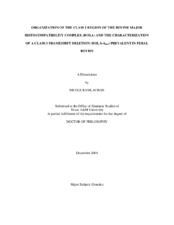| dc.description.abstract | The major histocompatibility complex (MHC) is a genomic region containing
genes of immunomodulatory importance. MHC class I genes encode cell-surface
glycoproteins that present peptides to circulating T cells, playing a key role in
recognition of self and non-self. Studies of MHC loci in vertebrates have examined
levels of polymorphism and molecular evolutionary processes generating diversity. The
bovine MHC (BoLA) has been associated with disease susceptibility, resistance and
progression. To delineate mechanisms by which MHC class I genes evolved to function
optimally in a species like cattle, it is necessary to study genomic organization of BoLA
to define gene content, and investigate characteristics of expressed class I molecules.
This study describes development of a physical map of BoLA class I region
derived from screening two BAC libraries, isolating positive clones and confirming gene
content, order and chromosomal location through PCR, novel BAC end sequencing
techniques, and selected BAC shotgun cloning and/or sequencing and FISH analysis. To
date, this is the most complete ordered BAC array encompassing the BoLA class I
region from the class III boundary to the extended class I region. Characterization of a
frameshift allele exhibiting trans-species polymorphism in Bos and Bison by flow
cytometry, real-time RT-PCR, 1D and 2D gel analysis is also described. This frameshift
allele encodes an early termination signal within the antigen recognition site (ARS) of
exon 3 of the BoLA BSA-Adel class I gene predicting a truncated class I protein that is
soluble. An ability to assess MHC diversity in populations and provision of animals with
defined MHC haplotypes and genetic content for experimental research is necessary in
developing a basis upon which to build functional studies to elucidate associations
between haplotype and disease in bovids.
The BoLA class I region is immunologically important for disease association
studies in an economically important species. This study provides knowledge of gene
content and organization within the class I MHC region in cattle, providing a template
for more detailed analysis and elucidation of complex disease associations through
functional genomics and comparative analysis, as well as evolution of the MHC in
bovids to optimize a populationÂ’s immune response. | en |


